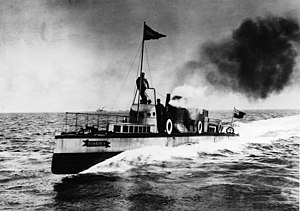Turbinia

| |
| History | |
|---|---|
| Launched | 1894 |
| Fate | Museum ship |
| General characteristics | |
| Displacement | 44.5 tons |
| Length | 103 ft 9 in (31.62 m) |
| Beam | 9 ft (2.7 m) |
| Draught | 3 ft (0.91 m) |
| Propulsion | list error: <br /> list (help) Three-stage axial-flow Parsons steam turbine driving two 12 ft 6 in (3.8 m) outer shafts, each with three 18 in (457 mm) diameter, 24 in (610 mm) pitch propellers, and one inner shaft with three propellers. 2,000 hp three-drum water-tube coal fired boiler with double ended 1,100 ft² (102 m²) heating surface. 200 lbf/in² (1.4 MPa), 170 lbf/in² (1.2 MPa) at the turbine |
| Speed | 34.5 knots (64 km/h) |
Turbinia was the first steam turbine powered steamship. Built as an experimental vessel in 1894, and easily the fastest ship in the world at that time, Turbinia was demonstrated dramatically at the Spithead Navy Review in 1897 and set the standard for the next generation of steamships, the majority of which were turbine powered. The vessel can still be seen at The Discovery Museum in Newcastle upon Tyne, England, while its original powerplant can be found at the London Science Museum.
Development
Charles Algernon Parsons invented the steam turbine in 1884, and having foreseen its potential to power ships he set up the Marine Steam Turbine Company with five associates in 1893. To develop this he had the experimental vessel Turbinia built of very light steel by the firm of Brown and Hood, based at Wallsend on Tyne.
The Admiralty was kept informed of developments, and Turbinia was launched on 2 August 1894. Despite the success of the turbine engine, initial trials with one propeller were disappointing. After discovering the problem of cavitation and constructing the first cavitation tunnel, Parsons' research led to him fitting three axial-flow turbines to three shafts, each shaft in turn driving three propellers. In trials this achieved a top speed of over 34 knots (63 km/h), so that "the passengers aboard would be convinced beyond all doubt Turbinia was Charles Parsons' winning North Sea greyhound".
Demonstration
Parsons' ship turned up unannounced[1] at the Navy Review for Queen Victoria's Diamond Jubilee at Spithead on 26 June 1897 in front of the Prince of Wales, Lords of the Admiralty and foreign dignitaries. As an audacious publicity stunt the Turbinia, which was much faster than all other ships of the time, raced between the two lines of large ships and steamed up and down in front of the crowd and princes with impunity, while easily evading a Navy picket boat that tried to stop it, indeed almost swamping it with its wake.[2]
From this clear demonstration of its speed and power and after further high speed trials attended by the Admiralty, Parsons set up the Turbinia Works at Wallsend which then constructed two turbine powered destroyers for the Navy, HMS Viper and HMS Cobra which were launched in 1899. Although both these vessels tragically came to grief, the Admiralty was convinced. In 1900 the Turbinia steamed to Paris and was shown to French officials then displayed at the Paris Exhibition.
The first turbine powered merchant vessel, the Clyde steamer TS King Edward, followed in 1901. (Her successor, the TS Queen Mary of 1932, is now a floating restaurant on the River Thames in London.) The Admiralty confirmed in 1905 that all future Royal Navy vessels were to be turbine powered, and in 1906 the first turbine-powered battleship, the revolutionary HMS Dreadnought, was launched.
Turbinia was cut into two pieces in 1927, but was restored in the 1960s, when she was put on display at Newcastle's Military Vehicle Museum. In 2000, the vessel was the focal point of a year-long £10.7m redevelopment programme at Newcastle's Discovery Museum. The gallery around Turbinia was the first area to be refurbished with the main part of the work involving raising the roof by one story to create viewing galleries on three levels.
